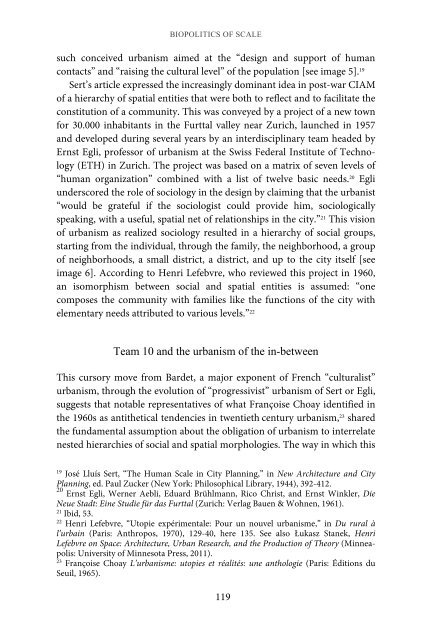Foucault, Biopolitics, and Governmentality
Foucault, Biopolitics, and Governmentality
Foucault, Biopolitics, and Governmentality
Create successful ePaper yourself
Turn your PDF publications into a flip-book with our unique Google optimized e-Paper software.
BIOPOLITICS OF SCALE<br />
such conceived urbanism aimed at the “design <strong>and</strong> support of human<br />
contacts” <strong>and</strong> “raising the cultural level” of the population [see image 5]. 19<br />
Sert’s article expressed the increasingly dominant idea in post-war CIAM<br />
of a hierarchy of spatial entities that were both to reflect <strong>and</strong> to facilitate the<br />
constitution of a community. This was conveyed by a project of a new town<br />
for 30.000 inhabitants in the Furttal valley near Zurich, launched in 1957<br />
<strong>and</strong> developed during several years by an interdisciplinary team headed by<br />
Ernst Egli, professor of urbanism at the Swiss Federal Institute of Technology<br />
(ETH) in Zurich. The project was based on a matrix of seven levels of<br />
“human organization” combined with a list of twelve basic needs. 20 Egli<br />
underscored the role of sociology in the design by claiming that the urbanist<br />
“would be grateful if the sociologist could provide him, sociologically<br />
speaking, with a useful, spatial net of relationships in the city.” 21 This vision<br />
of urbanism as realized sociology resulted in a hierarchy of social groups,<br />
starting from the individual, through the family, the neighborhood, a group<br />
of neighborhoods, a small district, a district, <strong>and</strong> up to the city itself [see<br />
image 6]. According to Henri Lefebvre, who reviewed this project in 1960,<br />
an isomorphism between social <strong>and</strong> spatial entities is assumed: “one<br />
composes the community with families like the functions of the city with<br />
elementary needs attributed to various levels.” 22<br />
Team 10 <strong>and</strong> the urbanism of the in-between<br />
This cursory move from Bardet, a major exponent of French “culturalist”<br />
urbanism, through the evolution of “progressivist” urbanism of Sert or Egli,<br />
suggests that notable representatives of what Françoise Choay identified in<br />
the 1960s as antithetical tendencies in twentieth century urbanism, 23 shared<br />
the fundamental assumption about the obligation of urbanism to interrelate<br />
nested hierarchies of social <strong>and</strong> spatial morphologies. The way in which this<br />
19 José Lluís Sert, “The Human Scale in City Planning,” in New Architecture <strong>and</strong> City<br />
Planning, ed. Paul Zucker (New York: Philosophical Library, 1944), 392-412.<br />
20<br />
Ernst Egli, Werner Aebli, Eduard Brühlmann, Rico Christ, <strong>and</strong> Ernst Winkler, Die<br />
Neue Stadt: Eine Studie für das Furttal (Zurich: Verlag Bauen & Wohnen, 1961).<br />
21 Ibid, 53.<br />
22 Henri Lefebvre, “Utopie expérimentale: Pour un nouvel urbanisme,” in Du rural à<br />
l’urbain (Paris: Anthropos, 1970), 129-40, here 135. See also Łukasz Stanek, Henri<br />
Lefebvre on Space: Architecture, Urban Research, <strong>and</strong> the Production of Theory (Minneapolis:<br />
University of Minnesota Press, 2011).<br />
23 Françoise Choay L’urbanisme: utopies et réalités: une anthologie (Paris: Éditions du<br />
Seuil, 1965).<br />
119


